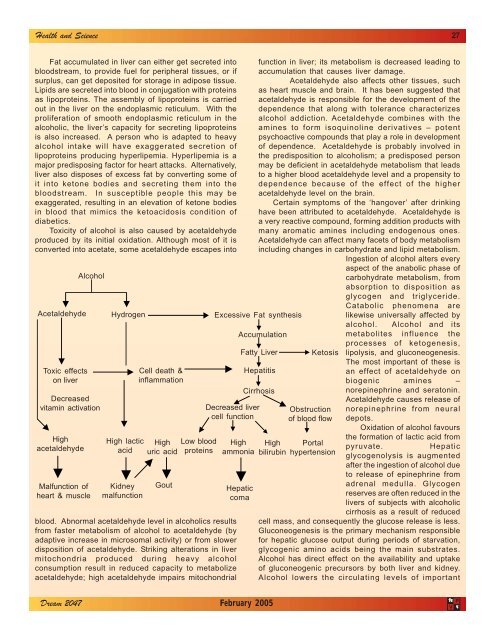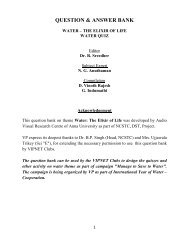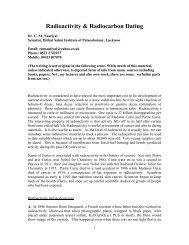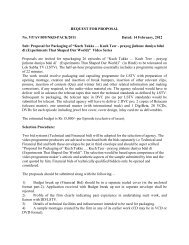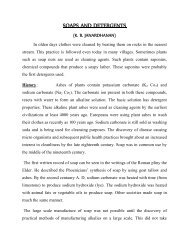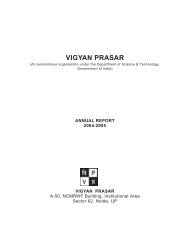Inside - Vigyan Prasar
Inside - Vigyan Prasar
Inside - Vigyan Prasar
Create successful ePaper yourself
Turn your PDF publications into a flip-book with our unique Google optimized e-Paper software.
Health and Science 27<br />
Fat accumulated in liver can either get secreted into<br />
bloodstream, to provide fuel for peripheral tissues, or if<br />
surplus, can get deposited for storage in adipose tissue.<br />
Lipids are secreted into blood in conjugation with proteins<br />
as lipoproteins. The assembly of lipoproteins is carried<br />
out in the liver on the endoplasmic reticulum. With the<br />
proliferation of smooth endoplasmic reticulum in the<br />
alcoholic, the liver’s capacity for secreting lipoproteins<br />
is also increased. A person who is adapted to heavy<br />
alcohol intake will have exaggerated secretion of<br />
lipoproteins producing hyperlipemia. Hyperlipemia is a<br />
major predisposing factor for heart attacks. Alternatively,<br />
liver also disposes of excess fat by converting some of<br />
it into ketone bodies and secreting them into the<br />
bloodstream. In susceptible people this may be<br />
exaggerated, resulting in an elevation of ketone bodies<br />
in blood that mimics the ketoacidosis condition of<br />
diabetics.<br />
Toxicity of alcohol is also caused by acetaldehyde<br />
produced by its initial oxidation. Although most of it is<br />
converted into acetate, some acetaldehyde escapes into<br />
Alcohol<br />
Acetaldehyde Hydrogen Excessive Fat synthesis<br />
Toxic effects<br />
on liver<br />
Decreased<br />
vitamin activation<br />
High<br />
acetaldehyde<br />
Malfunction of<br />
heart & muscle<br />
High lactic High<br />
acid uric acid<br />
Kidney<br />
malfunction<br />
Cell death &<br />
inflammation<br />
Gout<br />
Low blood<br />
proteins<br />
High<br />
ammonia<br />
blood. Abnormal acetaldehyde level in alcoholics results<br />
from faster metabolism of alcohol to acetaldehyde (by<br />
adaptive increase in microsomal activity) or from slower<br />
disposition of acetaldehyde. Striking alterations in liver<br />
mitochondria produced during heavy alcohol<br />
consumption result in reduced capacity to metabolize<br />
acetaldehyde; high acetaldehyde impairs mitochondrial<br />
function in liver; its metabolism is decreased leading to<br />
accumulation that causes liver damage.<br />
Acetaldehyde also affects other tissues, such<br />
as heart muscle and brain. It has been suggested that<br />
acetaldehyde is responsible for the development of the<br />
dependence that along with tolerance characterizes<br />
alcohol addiction. Acetaldehyde combines with the<br />
amines to form isoquinoline derivatives – potent<br />
psychoactive compounds that play a role in development<br />
of dependence. Acetaldehyde is probably involved in<br />
the predisposition to alcoholism; a predisposed person<br />
may be deficient in acetaldehyde metabolism that leads<br />
to a higher blood acetaldehyde level and a propensity to<br />
dependence because of the effect of the higher<br />
acetaldehyde level on the brain.<br />
Certain symptoms of the ‘hangover’ after drinking<br />
have been attributed to acetaldehyde. Acetaldehyde is<br />
a very reactive compound, forming addition products with<br />
many aromatic amines including endogenous ones.<br />
Acetaldehyde can affect many facets of body metabolism<br />
including changes in carbohydrate and lipid metabolism.<br />
Ingestion of alcohol alters every<br />
aspect of the anabolic phase of<br />
carbohydrate metabolism, from<br />
absorption to disposition as<br />
glycogen and triglyceride.<br />
Accumulation<br />
Fatty Liver Ketosis<br />
Hepatitis<br />
Cirrhosis<br />
Decreased liver<br />
cell function<br />
Hepatic<br />
coma<br />
High<br />
bilirubin<br />
Obstruction<br />
of blood flow<br />
Portal<br />
hypertension<br />
Catabolic phenomena are<br />
likewise universally affected by<br />
alcohol. Alcohol and its<br />
metabolites influence the<br />
processes of ketogenesis,<br />
lipolysis, and gluconeogenesis.<br />
The most important of these is<br />
an effect of acetaldehyde on<br />
biogenic amines –<br />
norepinephrine and seratonin.<br />
Acetaldehyde causes release of<br />
norepinephrine from neural<br />
depots.<br />
Oxidation of alcohol favours<br />
the formation of lactic acid from<br />
pyruvate. Hepatic<br />
glycogenolysis is augmented<br />
after the ingestion of alcohol due<br />
to release of epinephrine from<br />
adrenal medulla. Glycogen<br />
reserves are often reduced in the<br />
livers of subjects with alcoholic<br />
cirrhosis as a result of reduced<br />
cell mass, and consequently the glucose release is less.<br />
Gluconeogenesis is the primary mechanism responsible<br />
for hepatic glucose output during periods of starvation,<br />
glycogenic amino acids being the main substrates.<br />
Alcohol has direct effect on the availability and uptake<br />
of gluconeogenic precursors by both liver and kidney.<br />
Alcohol lowers the circulating levels of important<br />
fo<br />
fo<br />
Dream 2047 February 2005 V<br />
P<br />
iz<br />
iz


